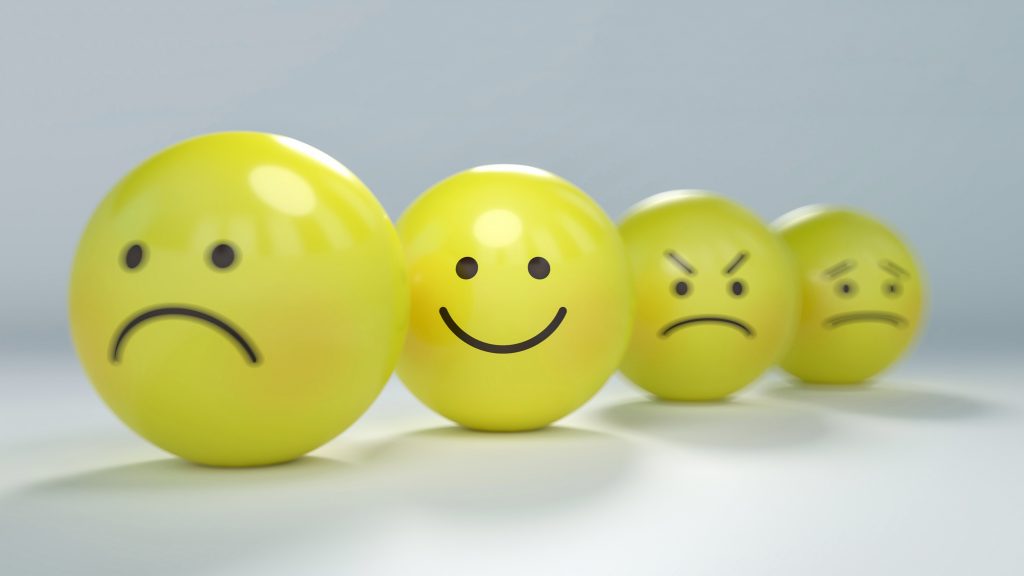Are You Masking Your Emotions?
by Richard Firth-GodbehereWhat effect has the pandemic and had on our ability to read emotions and facial expressions? Has it hindered our emotional communication?

Just the other day, I was out shopping at a supermarket. Like a fool, I’d found myself short of supplies on a Saturday, and so had to brave the baying weekend hordes as they rampaged through the store in their hundreds. Keeping socially distanced – as I still try to do despite Freedom Day giving us the thumbs up to spread the Delta variant liberally – was nigh-on impossible. To my great delight, those in the store were (mostly) masked up and being careful. Or at least, as careful as possible when half a town’s population gets stuck in a big metal box all at once.
It didn’t take long before the inevitable happened. As I rounded the corner between the pet food aisle and frozen produce, I found myself trolley-to-trolley with another shopper. He moved right; I moved left. He moved left: I moved right. And again. and again. We were at an impasse. Finally, he said, “I’ll go this side”, with a smile. I agreed to his plan and smiled back, and then we were both free at last to fight over the last still-yellow bananas.
Or at least I think he was smiling. It’s hard to tell because he was wearing a mask, so all I could make out were his eyes. It seemed to me that they were smiling eyes, but what does that even mean? It got me thinking about masks, emotions, and facial expressions.
Emotional Communication
Anyone who knows me will know that I often rail against the idea that specific emotions cause certain facial expressions. As I’ve written elsewhere, it’s an idea based on decades-old science that’s simply wrong. Take the ‘gape face’ for example. Even now, many outstanding scientists will insist that when a human, any human, feels the emotion of disgust, they express something called the ‘gape face’. That’s downturned lips with a wrinkled nose and brow and, depending on who you ask, a slight widening of the mouth. The issue is that this supposed ‘universal’ expression of disgust is both not universal and not solely used to express disgust.
On the first point, disgust itself is a highly cultural thing. Very few languages have words that map precisely onto the English word ‘disgust’. Moreover, what each society finds repulsive varies greatly. How many of you would enjoy a bowl of salted mealworms at the cinema? And yet, having tried them, I would.

On the second point, children don’t seem able to recognise the difference between anger and disgust faces until they’re about nine years old. Gape faces are also regularly expressed as a sign of confused disagreement. A gape to accompany a “huh”?
My point is, emotion faces are almost certainly not universal. But that doesn’t mean humans don’t use their faces to communicate their feelings. It’s just that, like any other part of language, you learn your facial vocabulary as a baby based on your parents’ reactions. This is likely why people born without sight tend to pull similar emotion faces to others in their culture – expressions are as central a part of language as the first coherent “mama”. And that difference brings me to the educated hunch about masks that I have.
Masking Expressions
In the West, there’s a lot of pushback against wearing masks based on endless streams of misinformation. Masks cause a build-up of CO2 (they don’t), mask-wearing is a way for the government to control us (it isn’t), and so on. The real reason, I’m told, is that many people don’t like being told what to do or what to wear. But that seems odd, as most antimaskers are happy to wear underpants, another garment worn solely for sanitary purposes (and government control, I reckon!). It occurred to me that there must be something deeper behind this fear of authority, something emotional.
In parts of Asia like Japan, things are different. Mask wearing is expected; it’s just something you do. It’s been something you do since long before the pandemic. A big part of that is due to the mindset of a collectivist society versus an individualist one. I won’t go into that here (you’ll have to buy my book, A Human History of Emotion when it comes out for more on that). Another reason, I think, is the different ways we express our emotions.

In Western societies, emotions are primarily about the bottom half of our faces. The gape face is a great example. Other than a furrowed brow, that expression focuses on the lips, the wrinkled nose, the slightly open mouth. Not so in places like Japan. In Japan, emotions are as much about the top half of the face as the bottom, and the eyes are essential. Don’t believe me? Then let’s compare them using the most scientific of tools: Emoticons.
The Eyes Have It
Long ago, in the dim distant past of 1982, a man called Scott Fahlman thought it’d be a great idea for people to mark the comments on an internet bulletin board with 🙂 for jokes and 🙁 for being serious. These were the first electronic emoticons, and they quickly became the mainstay of nerds everywhere. As texting on mobile phones took off in the late 90s, emoticons went mainstream and soon began to litter every message sent by anyone who was feeling anything.
The early emoticons had an East-West difference. US emoticons are written sideways and always focus on the mouth: 🙂 for happy, 🙁 for sad. Japan has their own version of emoticons they call Kaomoji. In contrast to emoticons, these are horizontal and focus on the eyes. ^_^ for happy, ‘_’ for sad. Although the modern descendants of emoticons – emojis – are becoming increasingly homogenized as social media becomes ever more global, there are still some remnants of the eye-focus in these more sophisticated representations. One example is sad, which is a mouthy ☹️ in the West and an eye-watering 😭 in Japan. This observation about online emotional expressions matches with other studies that have noticed a similar thing in real life. It appears that people from Asia focus more on the eyes than the mouth when reading the emotions of others and communicating their own. And that brings me to the meat of my hypothesis.

Masking your feelings
I think there’s more push-back in the West against masks not only because we are individualistic societies, but because when a Westerner wears a mask, it’s harder to know how they feel. As a collective, people in masks become emotionless, robotic, and that makes them seem controlled. It’s like some great power is directing their behaviour. It’s a descent down the uncanny valley that might be too much for some, so they battle against becoming one of these feelingless sheep(le?). In Asia, mask wearing is a duty to protect others, but, as importantly, it doesn’t inhibit how many Asains express their emotions. So they don’t see robots, they see people. That makes all the difference.
If nothing else, it’s a wonderful example of how different cultures express their emotions in different ways and the types of consequences that can have. For me, I’ll keep on wearing my mask in shops and the like until I know my spit is unlikely to harm you when we bump trolleys. That includes giving you my colds, flu and the whole range of other illnesses that mask-wearing is shown to reduce. l’ll just have to try harder to smile with my eyes while not coming over as some sort of weirdo.

Dr Richard Firth-Godbehere is an Honorary Research Fellow at the Centre for the History of the Emotions, Queen Mary University of London. His award-winning research and forthcoming book, A Human History of Emotions, walks the line between history, psychology, linguistics, and futurism. You can find him on Twitter at @DrRichFG.
If you would like to reuse this content please contact us for details
Subscribe to The Cosmic Shambles Network Mailing list here.

